Spring Chores in the Pollinator Garden
go.ncsu.edu/readext?989262
en Español / em Português
El inglés es el idioma de control de esta página. En la medida en que haya algún conflicto entre la traducción al inglés y la traducción, el inglés prevalece.
Al hacer clic en el enlace de traducción se activa un servicio de traducción gratuito para convertir la página al español. Al igual que con cualquier traducción por Internet, la conversión no es sensible al contexto y puede que no traduzca el texto en su significado original. NC State Extension no garantiza la exactitud del texto traducido. Por favor, tenga en cuenta que algunas aplicaciones y/o servicios pueden no funcionar como se espera cuando se traducen.
Português
Inglês é o idioma de controle desta página. Na medida que haja algum conflito entre o texto original em Inglês e a tradução, o Inglês prevalece.
Ao clicar no link de tradução, um serviço gratuito de tradução será ativado para converter a página para o Português. Como em qualquer tradução pela internet, a conversão não é sensivel ao contexto e pode não ocorrer a tradução para o significado orginal. O serviço de Extensão da Carolina do Norte (NC State Extension) não garante a exatidão do texto traduzido. Por favor, observe que algumas funções ou serviços podem não funcionar como esperado após a tradução.
English
English is the controlling language of this page. To the extent there is any conflict between the English text and the translation, English controls.
Clicking on the translation link activates a free translation service to convert the page to Spanish. As with any Internet translation, the conversion is not context-sensitive and may not translate the text to its original meaning. NC State Extension does not guarantee the accuracy of the translated text. Please note that some applications and/or services may not function as expected when translated.
Collapse ▲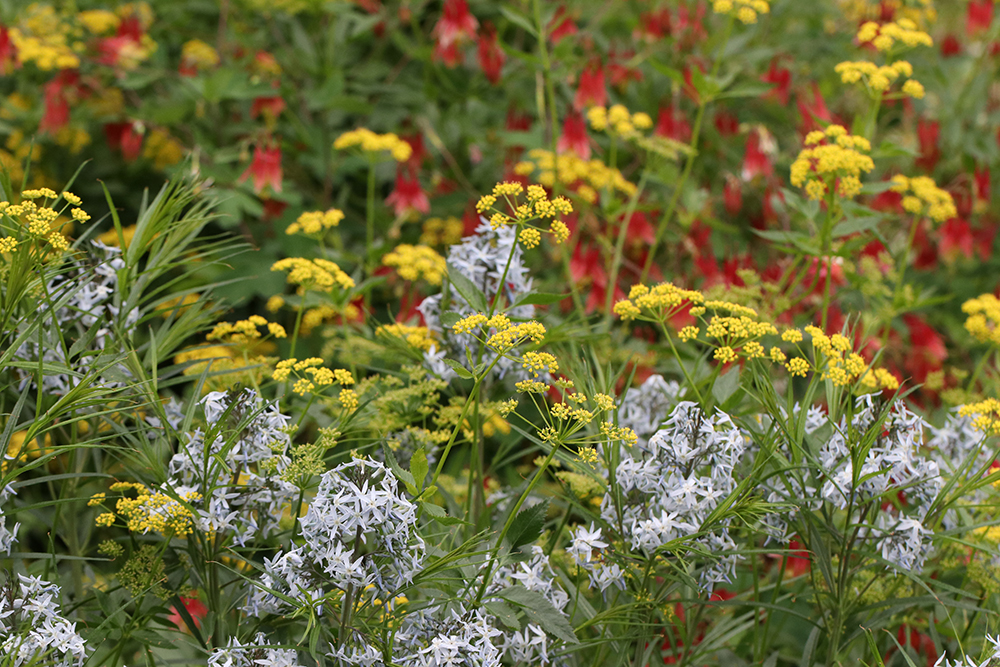
Arkansas blue star, golden alexander, and eastern wild columbine in the spring. Photo by Debbie Roos.
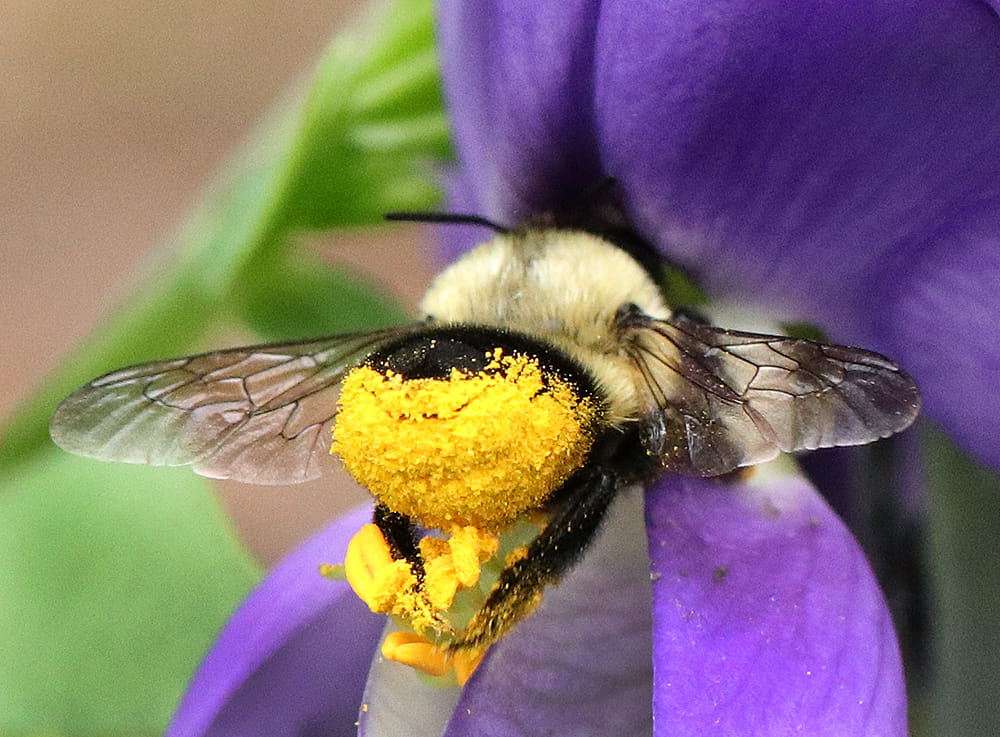
Leafcutter bee foraging on dwarf wild indigo in the spring. Photo by Debbie Roos.
Around mid- to late February things start kicking into high gear in Cooperative Extension’s Pollinator Paradise Demonstration Garden. Usually I have taken most of January off in the garden. I start back with some weeding in February, maybe some removal of “spready” plants. But by late February I can feel that spring is coming and it’s time to get serious about spring chores so I mobilize my volunteers and we start getting the garden ready for the season. These are the primary tasks we tackle in the spring:
Cut Back Plants
In my article Fall Chores in the Pollinator Garden I go into detail (with lots of photos) discussing why we don’t cut everything back when plants have died back at the end of the year. In short, it’s so that we leave seed for birds as well as overwintering shelter for invertebrates and other wildlife. Plant stems and grasses also provide important structure in the garden through the winter as well as visual appeal.
The biggest chore in the late winter and early spring (late February-March) in the pollinator garden is to cut all the herbaceous plants back that you let overwinter from the previous year.
About 25% of our native bee species in North Carolina nest in cavities like plant stems. Most of these bees nest in hollow stems but a few species like carpenter bees, some leafcutter bees, and small resin bees can nest in stems with a soft pithy center.
Wen you cut plants back in early spring, cut them back to a height of 8-24 inches. This will open them up to the many species of stem-nesting bees that will be emerging in the spring looking for nesting sites: mason bees, leafcutting bees, resin bees, yellow-faced bees, and small carpenter bees.
My article Provide Nesting Habitat for Native Bees through Plant Stems in Your Garden provides lots of details and photos on managing stems in the garden for stem-nesting bees.
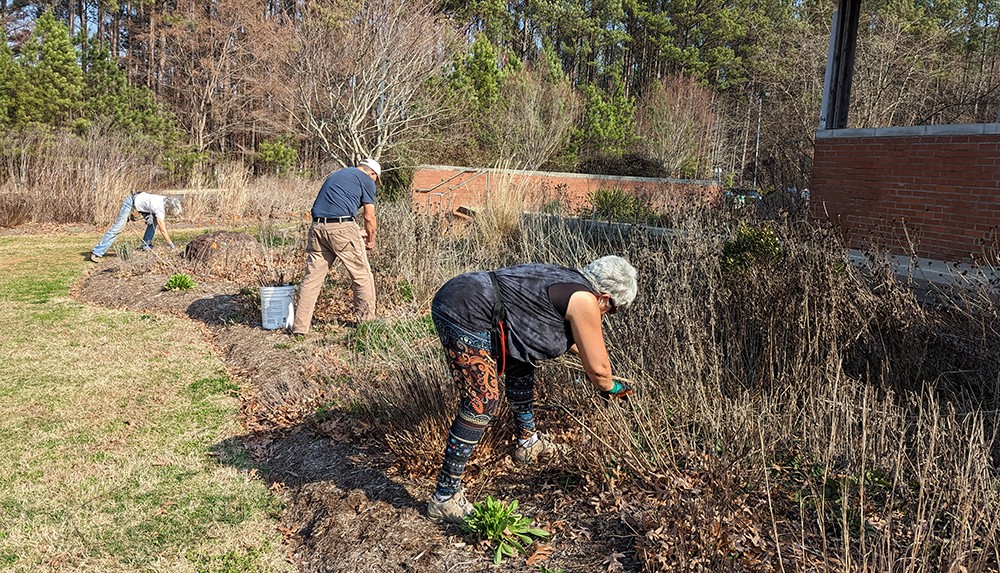
Cutting the dried stems back from the previous season in early spring. Stems are cut back to a height of 8-24 inches to create cavities for stem-nesting bees. Photo by Debbie Roos.
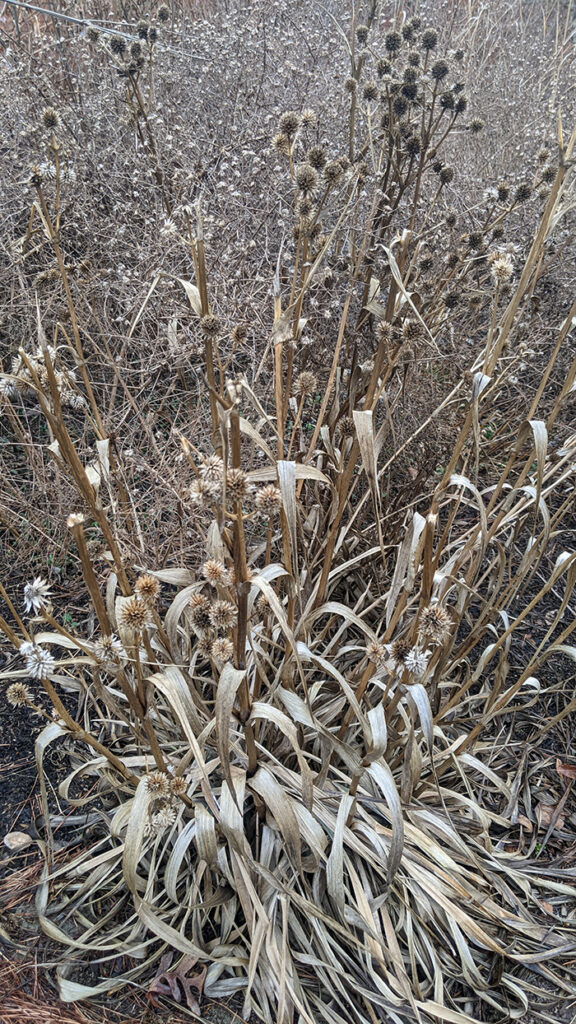
Overwintered, intact rattlesnake master (Eryngium yuccifolium) plant in early spring. Photo by Debbie Roos.
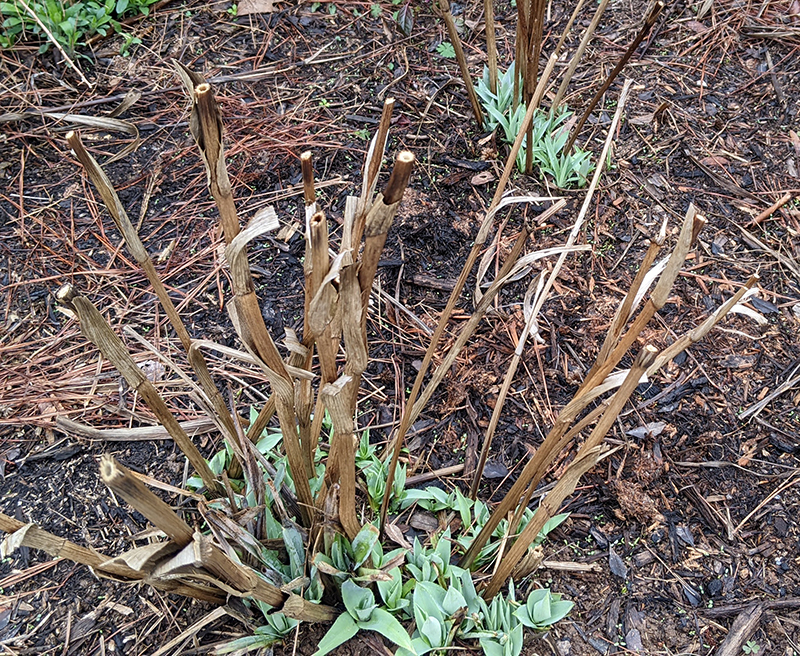
Rattlesnake master after stems are cut back to about 18 inches in early spring. Removing the dead leaves from the previous season also helps sunlight reach the new growth. Photo by Debbie Roos.

Close-up of hollow rattlesnake master stems after cutting. Photo by Debbie Roos.

About 25% of native bees in North Carolina nest in hollow cavities like those found in plant stems. Above are a few examples of some of the native perennials in my pollinator garden that have hollow stems. Photo by Debbie Roos.
Weed
Weeding rivals cutting plants back as far as importance in the spring. There comes a certain point in the spring when all of a sudden it feels like the weeds are going to take over the garden beds and it seemingly happens overnight! Common spring weeds include chickweed (Stelleria media), creeping charlie (Glechoma hederacea), purple deadnettle (Lamium purpureum), dandelion (Taraxacum officinale), wild onion (Allium canadense), hairy bittercress (Cardamine hirsuta), mugwort (Artemisia vulgaris), and more. Some of these benefit pollinators and would be fine to leave in a lawn but I remove them from the pollinator garden where they multiply and outcompete the native perennials.
When the weeds get out of control I practice what I call “rescue weeding” where I concentrate first on weeding around the perennials that have been overtaken by weeds to the point that you can barely see them. Once I have “rescued” those plants I can concentrate on weeding in more open areas where the weeds are not directly impacting neighboring plants.

In the spring it’s easy for weeds like chickweed to take over and overwhelm perennials in the garden before they emerge. Photo by Debbie Roos.

Purple deadnettle overtaking an emerging purple coneflower plant in the spring. Photo by Debbie Roos.

Eastern tiger swallowtail butterfly nectaring on creeping charlie, also called ground ivy. Even though this non-native perennial weed provides nectar for pollinators, it is invasive in North Carolina and should be removed from the garden. Photo by Debbie Roos.

Before “rescue weeding”: weeds overtaking native wild quinine. Photo by Debbie Roos.
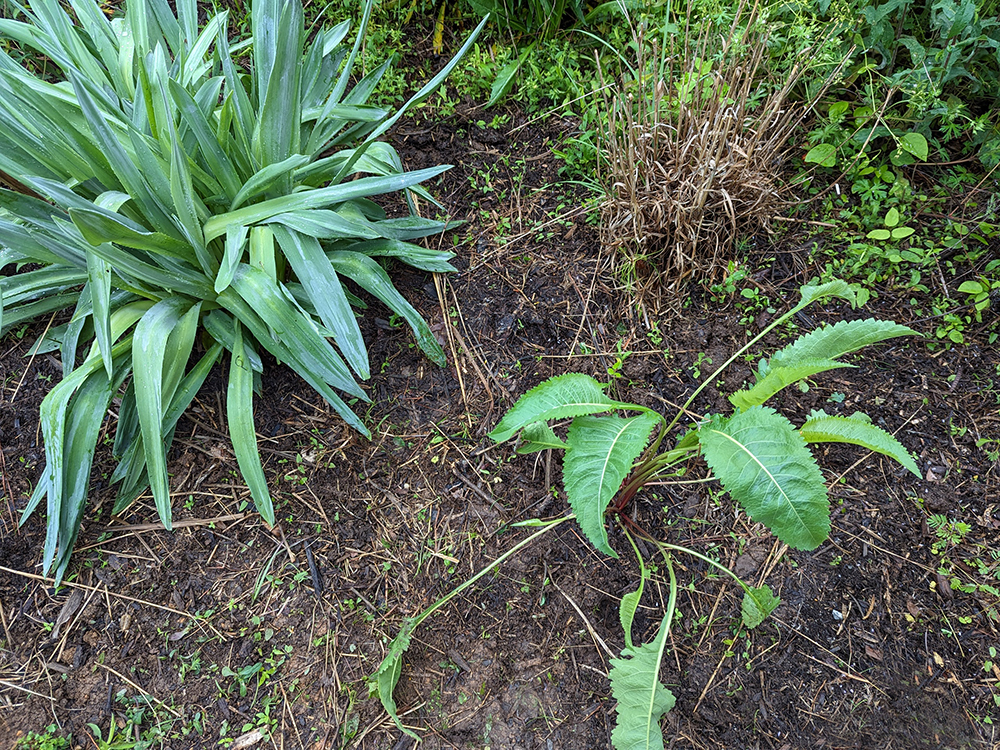
After “rescue weeding”: now the wild quinine is free from competition. This bed will be mulched once weeding is complete. Photo by Debbie Roos.
Divide / Remove Aggressive Spreaders
Another important task in the spring is to spend time removing some of the aggressive plants that spread throughout the garden and overrun other less competitive species. This is typically done in the spring and the fall. Aggressive species include cup plant (Silphium perfoliatum), spotted horsemint (Monarda punctata), golden alexander (Zizia aurea), poppy mallow (Callirhoe spp.), lyreleaf sage (Salvia lyrata), Arkansas bluestar (Amsonia hubrichtii), green-head coneflower (Rudbeckia laciniata), blazing star (Liatris spicata), ironweed (Vernonia spp.), splitbeard bluestem (Andropogon ternarius), asters (Symphyotrichum spp.), spiderwort (Tradescantia spp.), oxeye daisy (Helianthus helianthoides), orange coneflower (Rudbeckia fulgida), and others. If allowed to go unchecked, the biodiversity of the garden would severely decline as the less competitive species disappeared.

Three aggressive spreaders appear in this photo: spiderwort, prairie poppy mallow, and golden alexander. The spiderwort and golden alexander are NC natives and the poppy mallow is native to the mid-west. All of these species have to regularly be dug out of the garden to prevent them from overtaking other species. Photo by Debbie Roos.
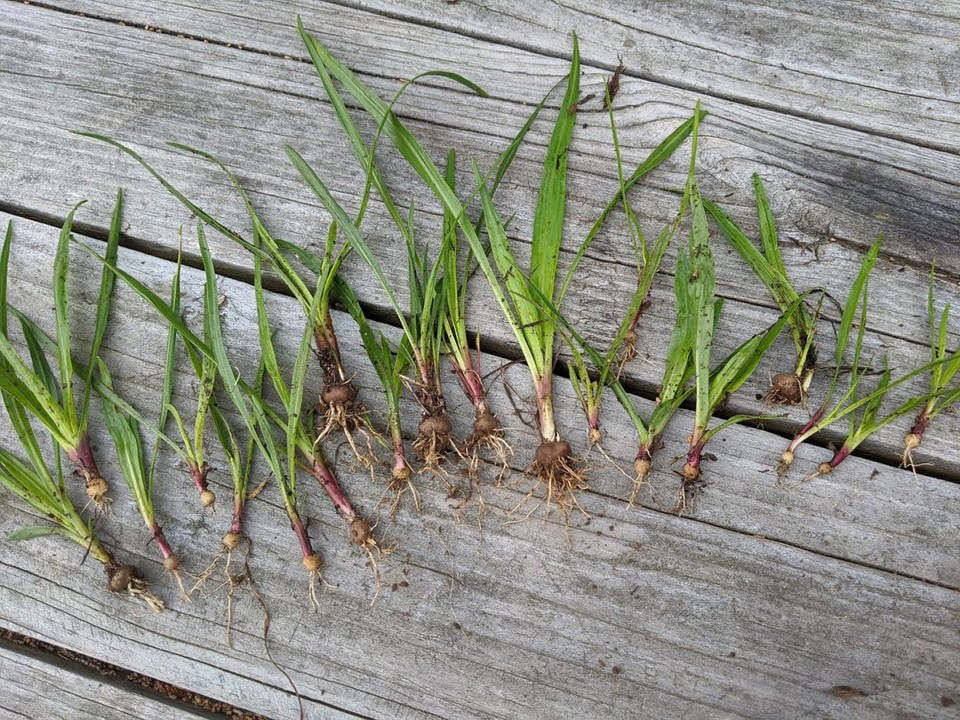
Blazing star will seed in aggressively throughout a garden and often take over in areas where you might not want it to go. The seedlings are easy to remove in the spring when they are small and can be replanted in other areas or shared with others. Photo by Debbie Roos.
Plant
We do the bulk of our planting in the fall (October-December) which is optimal for perennials and shrubs but we usually do a little replacement planting in the spring. This might be for the occasional plant death or gap that has opened up or for a marginally hardy Mediterranean herb that can’t be fall-planted.

The bulk of our planting is done in the fall but a few plants are planted in the spring. Photo by Debbie Roos.
Prune
Early spring is a good time to prune woody vines like native climbing aster (Ampelaster carolinianus). This is a very vigorous woody vine that is typically grown on a trellis. We cut it back hard, about by half, in mid-March, and then prune it back by about one-third another two times in the spring every few weeks as it grows out. We also maintain a couple of climbing asters as free-standing shrubs in the garden and prune them the same way in the spring.
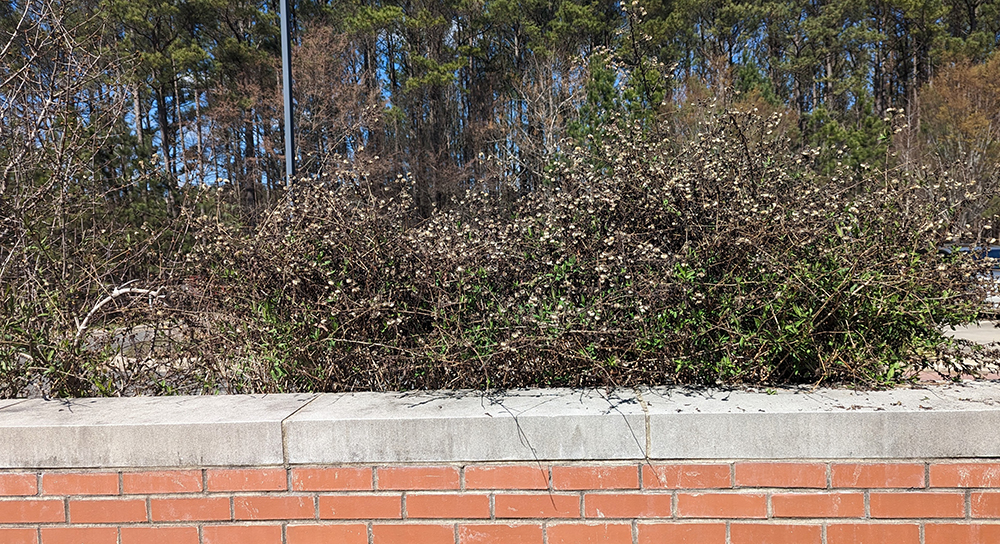
Overwintered native climbing aster vine in mid-March. Photo by Debbie Roos.

Climbing aster vine after pruning. It gets cut back about three times in the spring. Photo by Debbie Roos.
We do minimal shrub pruning in the pollinator garden since the shrubs are all native species and not maintained as hedges. Occasionally when a shrub becomes too large or misshapen I might cut it down to within 3-6 inches from the ground to give it a fresh start in what is called rejuvenation pruning. Not all shrubs can tolerate such severe pruning so make sure and do your research. Rejuvenation pruning can be done in stages (e.g., cutting back a portion of the stems each year) or all at once. It should only be done on plants that are well established.
In the pollinator garden I have used rejuvenation pruning on American beautyberry (Callicarpa americana) and buttonbush (Cephalanthus occidentalis) and they responded very well (see photos below). I do it right before growth begins in the spring. Because rejuvenation pruning stimulates growth I follow up the next year and thin out some of the new growth to prevent stem overcrowding.
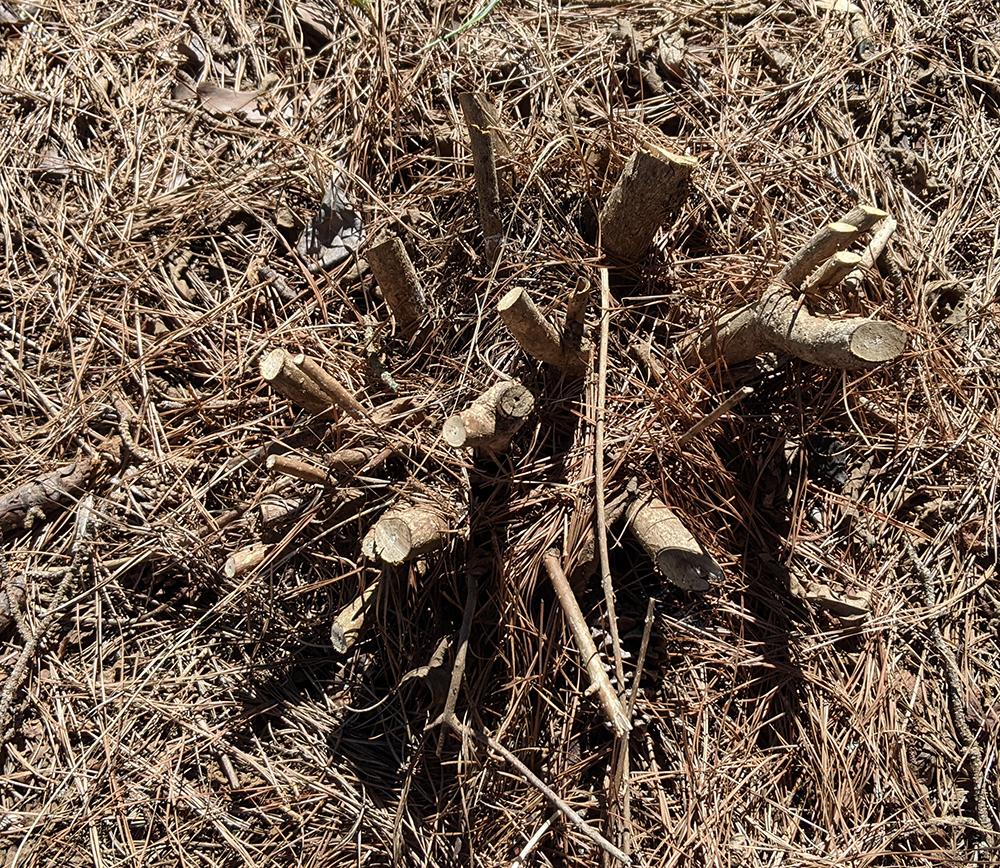
American beautyberry shrub that has been cut to the ground in late March before spring growth begins. Rejuvenation pruning is something that typically is done every 3-5 years at most. I have done it once in 15 years for these shrubs. Photo by Debbie Roos.
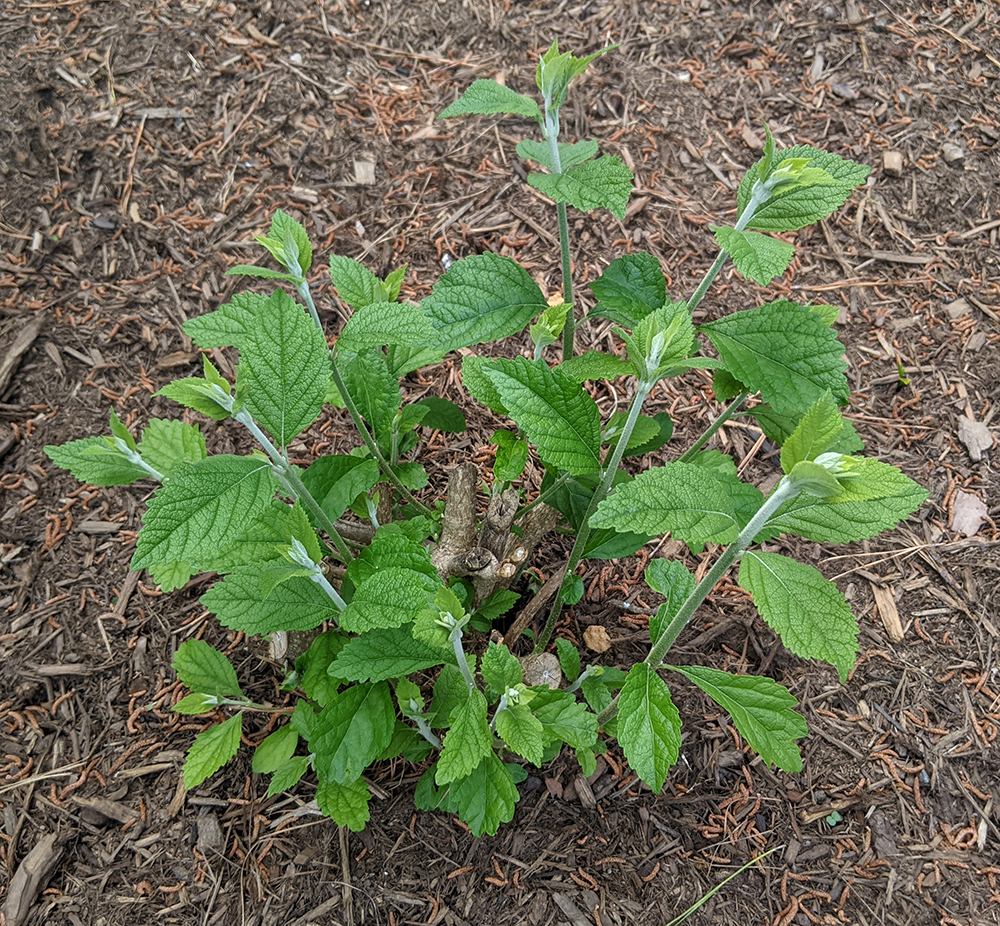
Regrowth on American beautyberry shrub six weeks after pruning. Photo by Debbie Roos.

Regrowth on buttonbush shrub six weeks after pruning. Some of these new stems will be thinned out the following year. Photo by Debbie Roos.
Deadhead
Deadheading is the removal of spent blooms. We only deadhead a few species of plants in the pollinator garden because for most species we want them to go to seed to provide food for wildlife. However, some species like blanketflower (Gaillardia spp.), purple coneflower (Echinacea purpurea), bee balm (Monarda spp.), culver’s root (Veronicastrum virginicum), garden phlox (Phlox paniculata), and others rebloom after deadheading so their bloom time can be extended if you want to spend the time deadheading.
We also deadhead certain species like golden alexander (Zizia aurea) to minimize seed dispersal as a way of managing their spread throughout the garden.
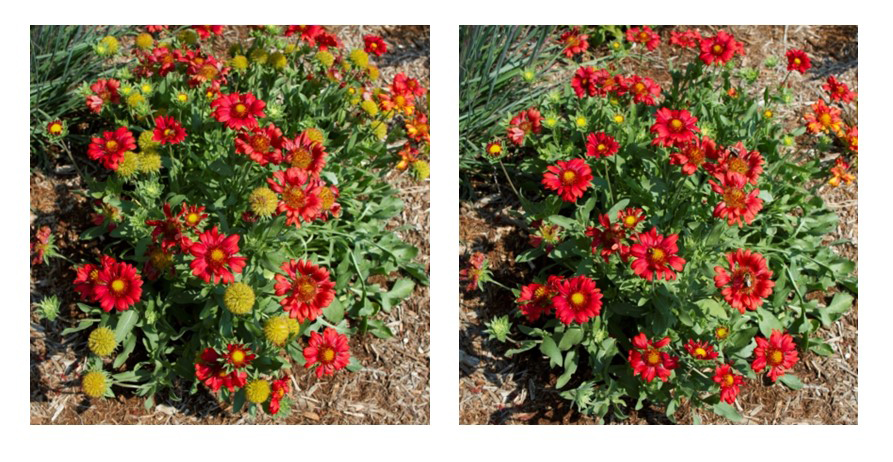
Species like lanceleaf blanketflower can be deadheaded to extend bloom period. The fuzzy yellow seedheads (shown in the left photo) are removed every few days (photo on right) to redirect the plant’s energy to produce flower buds and keep this species blooming from spring through fall. Photo by Debbie Roos.
Mulch
We mulch our beds once a year in early spring with about 3-4 inches of triple-shredded hardwood mulch. This annual application of mulch has greatly improved the soil tilth and organic matter content. We try to leave areas in most beds that are mulch-free for ground-nesting bees and have also created ground-nesting bee habitat on site.
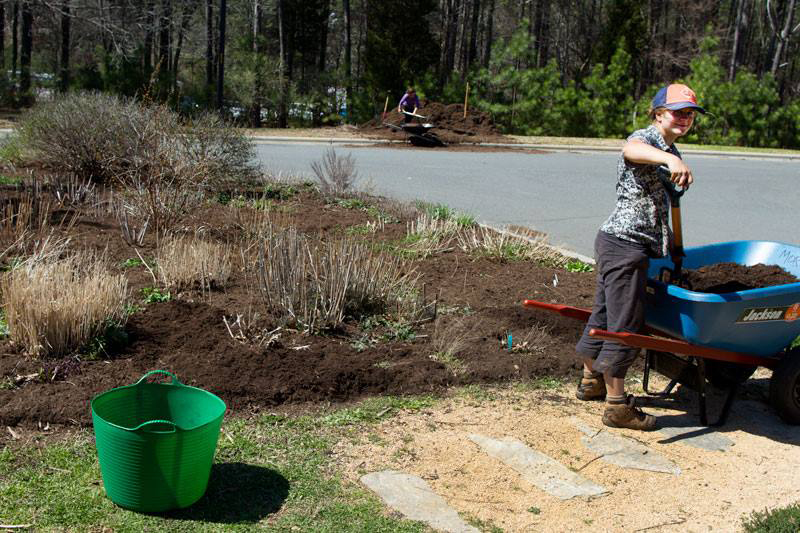
Mulching one of the pollinator garden beds with triple-shredded hardwood mulch. Photo by Debbie Roos.
Remove Invasive Chinese Praying Mantid Egg Cases
Folks of all ages delight in finding praying mantids in the garden. These charismatic predators are large and easy to spot and have a reputation for being cool beneficial insects, helping to dispatch garden pests.
But what if I told you I have an annual early spring ritual where I devote time to purposely removing and destroying praying mantid egg cases from my pollinator garden?
Why would I want to remove praying mantid egg cases? Because unfortunately the most common praying mantid in most North Carolina landscapes is the invasive non-native Chinese mantid (Tenodera sinensis), and they can be a menace in the garden. They produce the egg cases that I seek out and destroy.
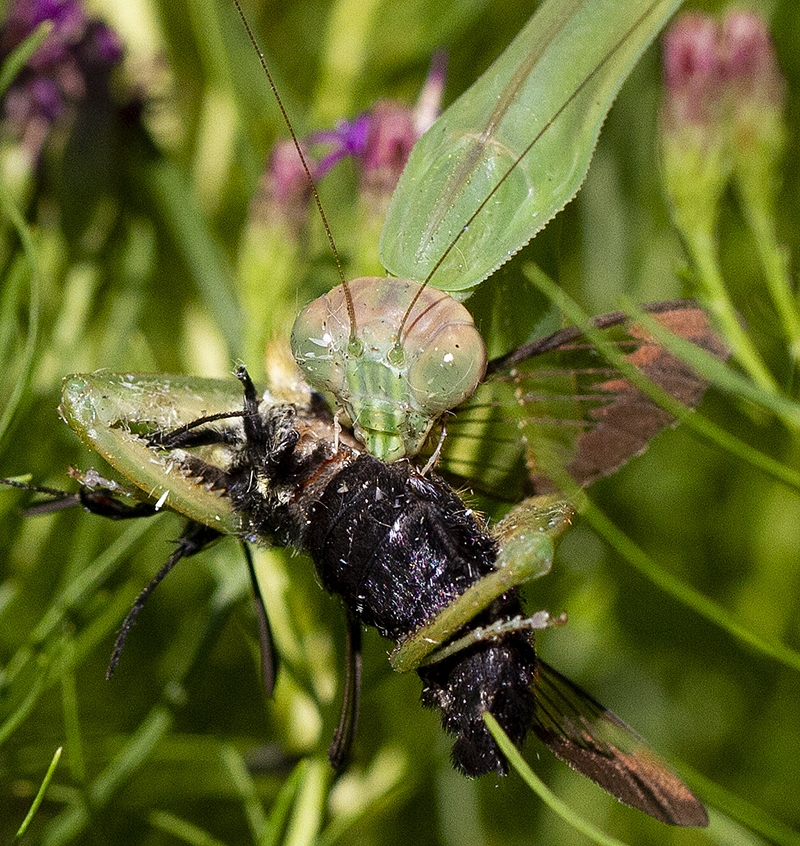
Chinese praying mantid feeding on a hummingbird moth on threadleaf ironweed. Sharp spines on the forelegs enable the mantid to securely hold on to their prey while feeding. Photo by Debbie Roos.
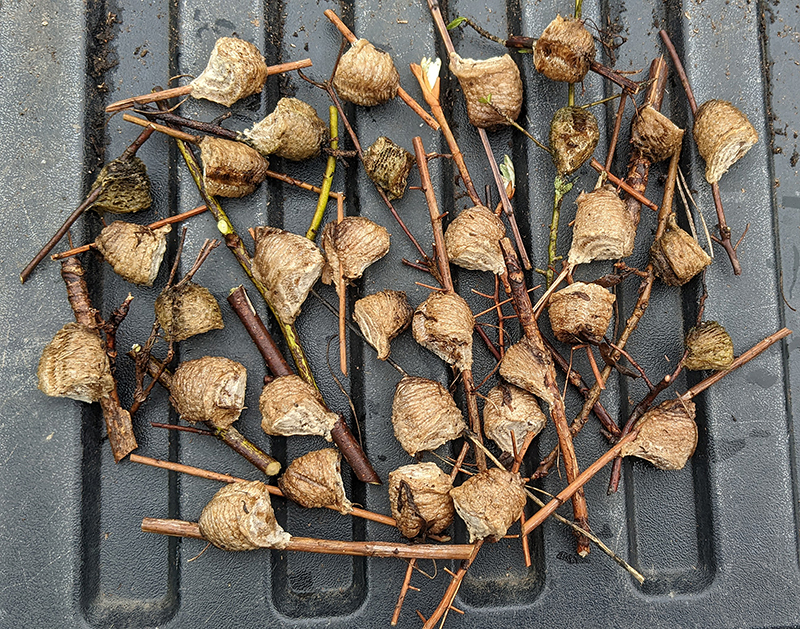
I found these 33 Chinese praying mantid egg cases in less than 30 minutes in my pollinator garden. I walked through my garden, pruners in hand, and snipped them from shrubs and perennials. Photo by Debbie Roos.
Read more about the Chinese praying mantis and the native Carolina praying mantis and learn what their egg cases look like and how to tell the difference. I have lots of photos posted on my article: Challenging the Conventional Wisdom about Praying Mantids. The Chinese praying mantid egg cases should be removed in early spring before they have a chance to hatch and disperse throughout the garden.
Resources for Further Learning
Snapshots from the Pollinator Garden
Challenging the Conventional Wisdom about Praying Mantids
Provide Nesting Habitat for Native Bees through Plant Stems in Your Garden
Fall Chores in the Pollinator Garden
Pollinator Paradise Demonstration Garden
Pruning Trees & Shrubs: General Pruning Techniques – NC State University
Pruning Trees & Shrubs: How to Prune Specific Plants – NC State University


